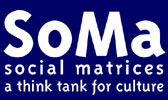
Trials
& Demos
A
key part of our research into public authoring and social knowledge
is the experimental platform we are building, which enables us to test
and develop ideas. Throughout the life of the project Proboscis will
run a series of trials and tests of the software – each time using
the experiences to reflect back upon our research and to design and
build a more useful and robust system.
Although our intention is not specifically to create a product, by following this participatory design methodology we anticipate that the Urban Tapestries system will emerge as a viable platform for public authoring. Whilst in its early developmental stages we will be running short trials and demos – once the software is more complete we intend to explore making parts of it available to the wider community.
The first trial was held in London in December 2003; 100 participants explored the concept of public authoring using HP iPaqs and a Locustworld 802.11 Wireless Mesh in Bloomsbury. Our recent field trial covered a 3km square area of Central London with around 15 participants using Sony Ericsson P800/P900s and the Orange GPRS network.
As part of our Social Tapestries research during 2004-2006, we will be trialling experiments based on the Urban Tapestries system in collaboration with civil society partners.
| All Threads | June 2004 Trial | December 2003 Trial |
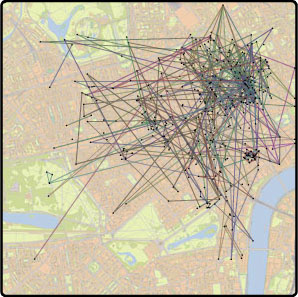 |
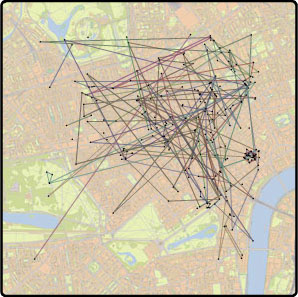 |
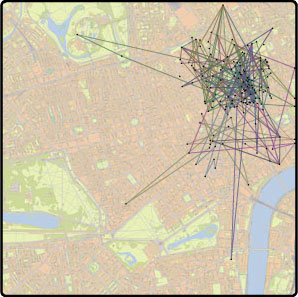 |
London
Trial June 2004
Proboscis
ran a four week field trial of the Symbian UIQ smartphone version of
UT in partnership with Orange, Ordnance Survey and France Telecom R&D
in June/July 2004 with 10
participants to test the system over a 4 week period. The aim of the
field trial was to give us a sense of why, what for and how people will
use it over time. The recruits are all being provided with Sony Ericsson
P800s with GPRS connections. Our partners in running the trial, Orange
and France Telecom R&D will be recruiting additional staff members
(not involved in the project) to take part too. Around 15 participants
tested the system in all.
The trial covered a 3km square area of central London and used cell id positioning from the Orange network to assist with location sensing. In addition to their actual public authoring using UT, the participants will be completing user experience questionnaires designed by Proboscis (with help from Zoe Sujon at MEDIA@LSE), which aim to help us explore the experiences of authoring, mobility and social and cultural contexts. The server log data will also be analysed to give us an understanding of such crucial issues as time, frequency, type of content, popularity of content etc...
We intended for this trial to help build a picture of the future of public authoring technologies such as Urban Tapestries, and to reveal not only the kinds of uses which we had already identified through our own research, but to allow for new ones to emerge simply by having different people use the system over time. As we evaluate the results from the trial we
We will be publishing a report on the trial and our research to date in September 2004.
The map
below indicates the area participants were able to annotate:
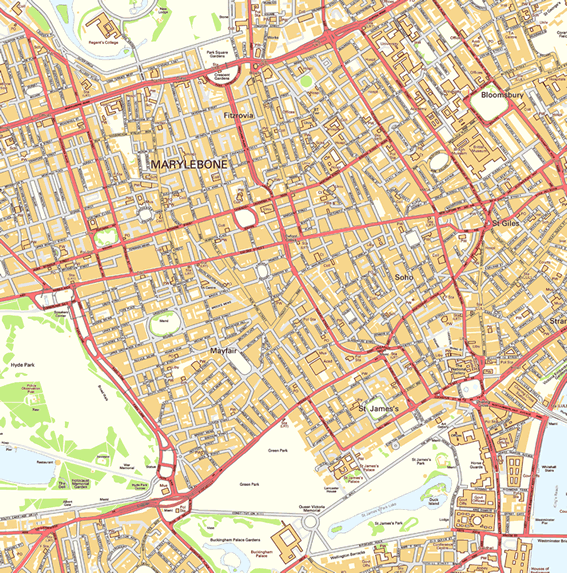
© Crown
copyright and database right. All rights reserved. Licence number 100/300/442
London
Trial December 2003
To
demonstrate the initial live prototype of the Urban Tapestries public
authoring platform, Proboscis ran a nine day public trial in the Bloomsbury
area of London during December 2003. Participants were able to borrow
an HP iPaq 5450 running the Urban Tapestries client software to drift
around the highlighted area (see map below) authoring and accessing
local content for a session of up to two hours.
online prototype
The aim of the trial was to introduce and explore the social and cultural possibilities of public authoring. Participants were invited to take part in an experiment to explore what the future for pervasive mobile networking might be like. To give a sense of context for this Proboscis devised a series of task-based activities for participants – encouraging them to embed their own content (stories, pictures, sounds) in geo-specific locations as part of the Tapestry's threads:
-
Imagine building your own location-based game to play with friends and neighbours, such as a treasure hunt or a spy game. The city, its inhabitants and the networks of transport and communications become a game engine of limitless possibilities.
-
Imagine creating a thread of local resources that would be useful or important to you if you lived in this area. For instance specialist food shops, bookstores, places to learn new things, exercise classes, social services, free concerts and films, public toilets and local dumps.
-
Imagine creating your own story woven through the area. For instance a romance or crime story, science fiction or horror (English country pursuits)!
-
Imagine annotating places for local activist campaigns or issues. For instance local pollution and the environment, building developments and regeneration, globalisation and local transport.
-
Imagine creating your own personal map of Bloomsbury. For instance quiet places to sit, favourite parks, family histories, unhappy memories and bad smells!
The Trial HQ was sited at Victoria House, a landmark building overlooking Bloomsbury Square recently refurbished by Garbe UK.
Feedback
100 Participants took part in the trial – their feedback from
their experiences was collated via a weblog and can be read in full
in the comments sections of each day's blog post here.
As part of our evaluation of the feedback Proboscis has posted a series of themes arising for public discussion here.
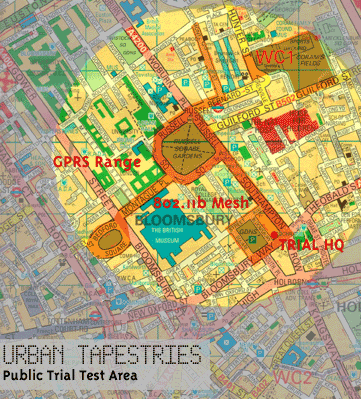 |
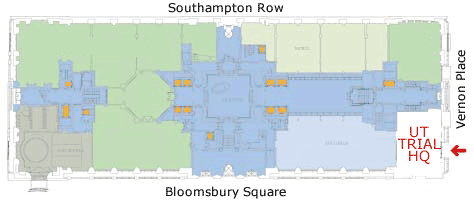 |
